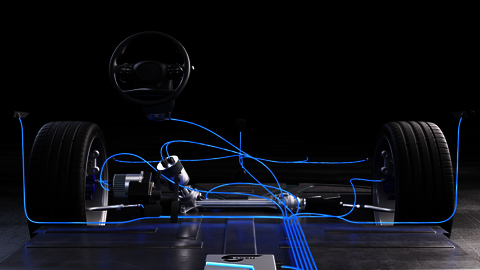Article Body
Drive By Wire Market: Steering Automotive Innovation Toward a Digital Future
The automotive sector is at the cusp of a technological revolution, as traditional mechanical control systems give way to electronic control solutions that promise greater precision, efficiency, and safety. Central to this transformation is the Drive by Wire (DbW) market, representing the future of vehicle control systems. Drive-by-wire replaces the conventional mechanical linkages for steering, braking, throttle, and shifting with electronic sensors, actuators, and control units, enabling seamless integration with electric and autonomous vehicle platforms.
Market Size and Growth Dynamics
In 2024, the global Drive By Wire Market is estimated to be worth approximately USD 41.5 bbillion. Forecasts project a robust compound annual growth rate (CAGR) of around 6.3 %, elevating market value to about USD 20.6 billion by 2024 and with some analyses extending growth to USD 41.5 billion by 2035. This rapid expansion highlights the surging adoption of electronic control systems in passenger and commercial vehicles worldwide.
Key factors propelling this growth include the rising demand for electric and hybrid vehicles, growing integration of autonomous driving technologies, and regulatory pushes for enhanced vehicle fuel efficiency and safety. The market's trajectory is further bolstered by continuous advances in sensor technology, embedded electronics, and artificial intelligence, which enhance the reliability and functionality of Drive by Wire systems.
Access Detailed Research on the Market Landscape - https://nextgenintelligencestats.com/drive-by-wire-market
Core Drivers Fuelling Market Expansion
- Electrification of Vehicles: Electric vehicles (EVs) and plug-in hybrid electric vehicles (PHEVs) inherently leverage electronic architectures, making drive-by-wire systems natural enablers for efficient, lightweight, and precision control.
- Autonomous and Advanced Driver Assistance Systems (ADAS): Autonomous Vehicles require highly responsive and redundant electronic controls to safely execute driving functions—areas where Drive by Wire excels through real-time signal processing and fail-safe mechanisms.
- Regulatory Mandates: Globally tightening emissions standards and Vehicle Safety regulations incentivize automakers to minimize mechanical complexity, reduce vehicle weight, and improve fuel economy, all facilitated by electronic control systems.
- Technological Innovation: Breakthroughs in sensors, actuators, IoT connectivity, and data analytics enable smarter diagnostics, predictive maintenance, and cyberattack resilience in Drive by Wire implementations.
Drive by Wire technology spans multiple control systems within vehicles:
- Throttle-by-Wire: Electronic control over acceleration, replacing traditional mechanical throttles.
- Brake-by-Wire: Electronic braking systems that enhance responsiveness and safety features.
- Steer-by-Wire: Electronic steering allowing flexible vehicle designs and integration with autonomous controls.
- Shift-by-Wire: Electronic transmission control improving gear shift precision and efficiency.
- Emerging Areas: Park-by-wire and suspension-by-wire systems that further enhance vehicle automation and ride quality.
Vehicle Type Adoption
Passenger vehicles dominate Drive by Wire market revenue, driven by consumer demand for advanced driving technologies and fuel economy. Commercial and fleet vehicles, such as buses and trucks, are rapidly adopting DbW as well, motivated by efficiency gains, lower maintenance costs, and ease of integration with logistic management systems.
Geographic Landscape
The Asia-Pacific region is the largest and fastest-growing market, led by automotive manufacturing powerhouses such as China, Japan, India, and South Korea. North America and Europe maintain substantial market shares owing to their advanced automotive industries and high consumer adoption rates of electric and Autonomous Vehicles. Emerging markets are also beginning to adopt Drive by Wire systems as cost reductions and technology diffusion continue.
Technological Insights
Drive by Wire systems work by converting driver inputs into electronic signals that control actuators connected to vehicle components. This approach eliminates mechanical linkages, reducing vehicle weight and improving overall system reliability. Redundancy and fail-safe designs are critical features, ensuring operational safety under failure conditions. The modular nature of DbW allows vehicle manufacturers greater flexibility in vehicle design, especially relevant to EVs and autonomous platforms.
Competitive Dynamics
Key players shaping the Drive by Wire market include established automotive component manufacturers and technology corporations such as Continental AG, Robert Bosch GmbH, ZF Friedrichshafen AG, Nissan Motor Co., Hitachi Ltd., Ficosa International SA, and others. These companies invest heavily in R&D, forming partnerships with vehicle OEMs to deploy next-generation drive-by-wire solutions integrated with AI, IoT, and digital vehicle architectures.
Innovative start-ups specializing in software integration, cybersecurity, and sensor technology are also influencing the market by introducing cutting-edge capabilities that address emerging challenges like system vulnerability and real-time data processing.
Challenges and Industry Barriers
Despite promising growth, Drive by Wire adoption faces several obstacles. Integrating DbW systems into existing vehicle platforms can be complex and costly, requiring redesigns and rigorous certification processes. Regulatory variability across regions can slow down market entry. Furthermore, cybersecurity threats present a critical concern, as increasingly connected vehicles must ensure trustworthy electronic control systems resistant to hacking or malfunction.
Future Outlook
The Drive by Wire market sits at the intersection of several key global trends—Vehicle Electrification, autonomous driving, and smart mobility. Over the next decade, Drive By Wire technology is expected to become a standard feature across most vehicle categories, enabling smarter and more Sustainable Mobility solutions. Its ability to reduce mechanical complexity while offering advanced safety and connectivity functions positions it as a cornerstone technology for Automotive Innovation.
As regulatory frameworks evolve to support greener and safer transportation, and as consumer preferences shift toward connected and autonomous vehicles, the demand for Drive by Wire systems will intensify. Companies that excel at innovating reliable, secure, and cost-effective DbW solutions will lead the market.
Conclusion
The Drive by Wire market is driving the automotive industry from traditional mechanical controls into a digitally managed era of vehicle operation. Valued at over USD 27 billion in 2025, the market's upward trajectory reflects the growing importance of electronic vehicle control systems in powering electrification, autonomous capabilities, and efficiency improvements. By embracing this technology, automakers can design safer, lighter, and smarter vehicles—paving the way toward a new era of mobility that is electric, autonomous, and connected.
For industry stakeholders, investors, and researchers, staying attuned to technological developments, regulatory standards, and shifting market demands within the Drive by Wire space is essential to capitalize on this dynamic and growing market segment.
Uncover Market Dynamics - Secure Your Complimentary Sample - https://nextgenintelligencestats.com/request-sample-report/36


Comments